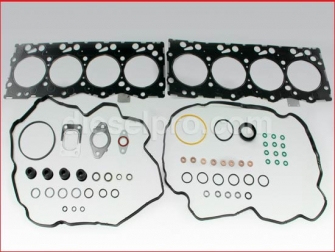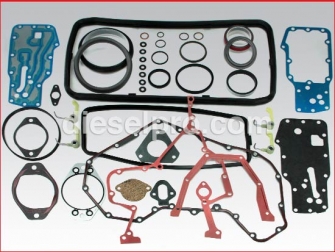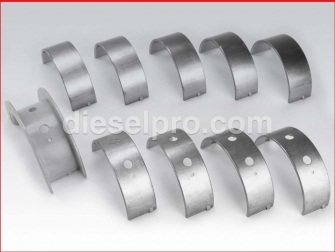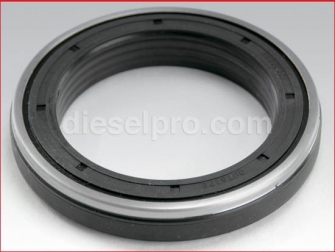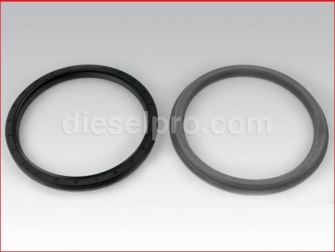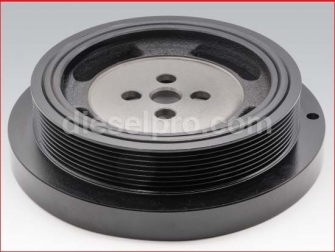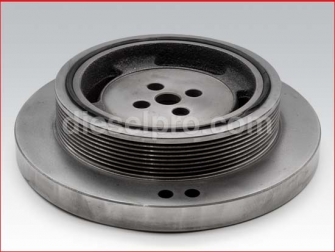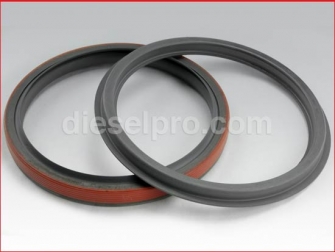Cummins ISB 4.5 Parts - Crankshaft Section
 Loading...
Loading... Cummins ISB 4.5L Crankshaft & Related Components
The Cummins ISB 4.5L engine is known for its compact size, high torque output, and impressive durability in demanding industrial and marine applications. At the heart of its rotating assembly lies the crankshaft — a precision-engineered component responsible for converting the linear motion of the pistons into rotational motion that powers the flywheel and drives the engine.
Maintaining the crankshaft and its related components is essential for preserving engine performance, minimizing wear, and ensuring the ISB 4.5 delivers the long service life Cummins engines are known for. This section provides a complete overview of the crankshaft system for the ISB 4.5L, including shell bearings, seal kits, and vibration dampers, with in-depth technical insights into their purpose, construction, and best practices for installation and maintenance.
Overview of the Cummins ISB 4.5L Crankshaft Assembly
The crankshaft is a forged steel component that runs through the bottom end of the ISB 4.5 engine block. Supported by a series of main bearings, it features offset crankpins that connect to the connecting rods, allowing the pistons to drive rotation. In a 4.5L four-cylinder configuration, the crankshaft must maintain perfect balance to reduce vibrations and distribute load evenly across the bearings.
Key functions of the ISB 4.5L crankshaft include:
-
Converting piston motion to rotation – The crankshaft transforms vertical piston movement into rotary motion that powers the transmission.
-
Driving auxiliary components – Via timing gears and belts, the crankshaft powers oil pumps, water pumps, alternators, and other accessories.
-
Maintaining engine balance – Counterweights integrated into the crankshaft reduce vibration and stress on the engine structure.
Because the crankshaft operates under extreme loads, precision machining, high-strength alloys, and proper lubrication are essential for its performance.
Crankshaft Bearings (Shell Sets)
The crankshaft rides on main bearings, often referred to as crankshaft shell bearings or shell sets. These are thin, precision-machined shells made of layered bearing materials designed to handle high loads while minimizing friction. In the ISB 4.5L, they are available in different sizes to accommodate factory specifications and wear conditions.
Standard Size Bearings
Standard crankshaft shell sets are installed in engines with crank journals that meet original specifications. These bearings ensure proper oil clearance and crankshaft support without modification to the crankshaft surfaces.
Benefits of standard bearings include:
-
Ideal for new or recently machined crankshafts
-
Maintains factory clearances for optimal oil pressure
-
Ensures smooth crankshaft rotation with minimal resistance
Oversize Bearings – 0.25 mm and 0.50 mm
When a crankshaft journal has been machined undersize during a rebuild, oversize bearings are used to restore the correct clearance. These bearings compensate for material removed during machining.
-
0.25 mm Oversize Bearings – Common for crankshafts with light journal wear that require minimal material removal.
-
0.50 mm Oversize Bearings – Used for crankshafts with more significant wear or scoring, requiring deeper machining to restore a smooth surface.
Why oversize bearings matter:
Using the correct oversize bearing ensures proper oil film thickness between the crankshaft and the bearing surface. Too much clearance can lead to low oil pressure and accelerated wear; too little clearance can cause binding and overheating.
Crankshaft Seals
To prevent oil leakage from the front and rear of the crankshaft, seal kits are used. These seals must withstand continuous crankshaft rotation while maintaining a tight seal against pressurized engine oil.
Front Crankshaft Seal Kits
The front crankshaft seal is positioned behind the vibration damper and timing gear cover. It prevents oil from escaping where the crankshaft protrudes at the front of the engine.
Typical front seal kit features:
-
Includes both the oil seal and installation sleeve
-
Designed to handle high rotational speeds and varying oil temperatures
-
Resistant to wear and compatible with diesel engine oils
Rear Crankshaft Seal Kits
The rear crankshaft seal is located between the crankshaft flange and the flywheel housing. It seals the rear main bearing area and prevents oil from leaking into the bellhousing.
There are two main configurations for the ISB 4.5 rear seals:
-
For dry clutch housings – A traditional seal and sleeve combination designed to prevent oil intrusion into a dry flywheel housing.
-
For wet clutch housings – A seal designed to operate in an environment with lubricated components, often featuring a double-lip design for extra sealing capability.
Best practices for seal installation:
-
Always inspect the crankshaft sealing surface for wear or scoring.
-
Use the correct installation tool to avoid damaging the seal lips.
-
Replace seals during any major crankshaft or flywheel service to prevent future leaks.
Vibration Dampers (Harmonic Balancers)
The vibration damper, also known as a harmonic balancer, is mounted to the front of the crankshaft. Its primary purpose is to reduce torsional vibration — the twisting forces that occur in the crankshaft as each cylinder fires.
How it works:
Inside the damper, a metal hub is connected to an outer ring by a rubber or viscous layer. As the crankshaft twists and vibrates, the damper absorbs and dissipates these forces, preventing them from traveling through the rest of the engine.
ISB 4.5 vibration damper options:
-
8.23-inch outside diameter – Commonly used in certain industrial configurations.
-
9.7-inch outside diameter – Offers increased damping capacity for higher-load applications.
Signs a vibration damper needs replacement:
-
Visible cracking or separation of the rubber layer
-
Unusual engine vibrations at certain RPMs
-
Belt misalignment or wobble in the damper pulley
Importance of Precision in Crankshaft Components
The crankshaft assembly is one of the most precision-engineered systems in the ISB 4.5L engine. Even minor wear, misalignment, or improper torque on the main bearing caps can lead to severe consequences, such as:
-
Bearing failure
-
Loss of oil pressure
-
Crankshaft scoring
-
Excessive vibration
For this reason, many professional rebuilders replace not only the crankshaft bearings but also the seals and dampers during any major overhaul.
Installation & Maintenance Tips
-
Check Bearing Clearances – Always measure oil clearance with plastigage or a micrometer to ensure specifications are within tolerance.
-
Lubricate Bearings on Assembly – Use assembly lube to prevent dry start-up damage.
-
Torque to Spec – Follow Cummins torque specifications for main bearing caps to avoid distortion.
-
Replace Seals Proactively – Oil leaks from worn seals can contaminate clutches or belts and cause costly downtime.
-
Inspect the Damper Regularly – Torsional vibration can cause crankshaft fatigue if the damper is failing.
Common Failure Causes and Prevention
-
Oil Starvation – Lack of lubrication leads to bearing overheating and crankshaft scoring.
-
Contamination – Dirt or metal debris in the oil can scratch bearing surfaces.
-
Overheating – Excessive heat can break down bearing material and cause warping.
-
Improper Machining – Incorrect crankshaft grinding can cause imbalance or misalignment.
Preventive measures:
-
Maintain clean oil and filters
-
Use only OEM-quality bearings and seals
-
Follow proper torque and alignment procedures during assembly
Why Choose Diesel Pro Power for ISB 4.5 Crankshaft Components
With over 40,000 satisfied customers worldwide, Diesel Pro Power supplies only premium-quality crankshaft components designed to match Cummins specifications. Whether you need a standard-size shell set, oversize bearings, a complete seal kit, or a new vibration damper, our inventory ensures quick delivery and reliable performance.
Our parts are precision-tested to ensure compatibility with the ISB 4.5L and QSB 4.5L platforms, giving you the confidence that your rebuild or repair will last for thousands of hours of operation.



 Free US Calls: 1-888-433-4735
Free US Calls: 1-888-433-4735 International: 305-545-5588
International: 305-545-5588






